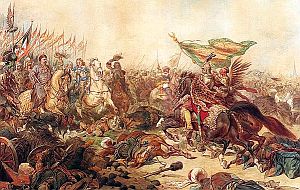Wikipedia
R.H. Allen:
Star Names
Ian Ridpath:
Star Tales
Universe Guide
Sea and Sky:
Constellations
SkyEye:
Constellations
IAU
Map
NASA:
Constellations
|
Wikipedia |
R.H. Allen: Star Names |
Ian Ridpath: Star Tales |
Universe Guide |
Sea and Sky: Constellations |
SkyEye: Constellations |
IAU Map |
NASA: Constellations |


|
|
Star LoreScutumThe Shield |
|


|
Scutum is a small constellation in the
southern hemisphere. It was one of seven new constellations designed by Polish astronomer Johannes Hevelius in 1687. |


|
|
For a brief overview of the main stars of the constellation, click the
Astronomy icon.
 For an alphabetic listing of the constellation's main object in different cultures, click the Index icon. |
|


|
|
Between 1641 and 1687, Polish astronomer Johannes Hevelius and his second wife
Elisabeth compiled data of 1,564 stars - the largest number ever observed with the naked eye.
 A star catalogue called Catalogus Stellarum Fixarum and a star atlas called Firmamentum Sobiescianum were published by Elisabeth Hevelius in 1690, three years Johannes Hevelius' death. They contained ten new constellations, seven of which are still used today. |

At the time of Hevelius, it was common for astronomers, to create constellations dedicated to their patrons. Hevelius' dedication was Scutum Sobiescianum,
Sobieskis Shield - honoring King John III Sobieski of Poland. In 1679, a fire destroyed
Hevelius' observatory, instruments and books. The observatory was rebuilt with the help of the Polish king and in 1684 Hevelius showed his gratitude,
introducing
Scutum Sobiescianum in the first scientific journal of the German-speaking lands of Europe, Acta Eruditorum.
 The Polish House of Sobieski used the coat of arms of the Polish nobility clan Janina. The original shield is plain without any objects on display. However, in his depiction of the shield, which was later picked up by other artists and astronomers, Hevelius adorned the shield with a Christian cross. |
  Hevelius' design as shown by Johann Leonhard Rost
Hevelius' design as shown by Johann Leonhard RostSource: atlascoelestis.com |
  Coat of Arms of the
Coat of Arms of theHouse of Sobieski Source: Wikipedia |
 At the time the constellation was created, King John III Sobieski was hailed as the "savior of Christianity" for his decisive role in the Battle of Vienna - the 1683 victory of the alliance of the Holy Roman Empire and the Kingdom of Poland over the Ottoman Empire at Kahlenberg Mountain near Vienna.  King John III was not the only monarch honored with his own constellation. When Hevelius introduced his creation, he specifically quoted Edmond_Halley, who six years earlier, in 1678 introduced Robur Carolinum to honor King Charles II of England.  The list of royal constellations includes King Louis XIV of France, King Frederick the Great of Prussia, Elector Johann Georg III of Saxony, King Stanisław of Poland and Lithuania and Holy Roman Emperor Leopold I.  The acceptance of these creations by the international astronomical community always depended on the political climate of the day and so, sooner or later all of the royal constellations disappeared from the world's star charts.  King Sobieski's shield survived, mainly because in 1879, US-American astronomer Benjamin Gould neutralized it. In his Uranometria Argentina, he simply called it Scutum. He also assigned Greek letters to the brightest stars. |
 King John III in the Battle of Vienna
King John III in the Battle of ViennaJuliusz Kossak, 1882; Source: Wikipedia
|
 Sea and Sky reports the name Ionnina (Latin for (King) John) for the brightest star in the constellation, but Gould simply labeled it α Scuti.  Gould's approach made Scutum eligible when the IAU in 1922 selected its final 88 constellations. Today, it is the only constellation related to a European monarch and one of only two modern constellations connected to a real historical person (the other one being Coma Berenices).  Sources: Wikipedia, Ian Ridpath |


|
|
Wild Duck Cluster
 Located within the boundaries of the constellation and visible to the naked eye is the star cluster Messier 11 (also known as NGC 6705). It is commonly called the Wild Duck Cluster, as its brighter stars form a triangle resembling a flock of ducks flying in V-Formation.  Source: Wikipedia |

|

|


|
|
A star cluster to be visited by a human space craft
 Another star cluster within the boundaries of the constellation (visible only with a telescope) is Messier 26 (also known as NGC 6694), 5,160 light years away from our sun.  NASA's space probe Pioneer 11, launched in 1973 was the first probe to pass the planet Saturn. The last contact with the probe took place in 1995. |
 Pioneer 11;
Wikipedia
Pioneer 11;
Wikipedia
|
 Pioneer Plaque;
Wikipedia
Pioneer Plaque;
Wikipedia
|
 Pioneer 11 now heads towards Messier 26. At a speed of 25,150 mph, it will arrive at the star cluster in less than one million years (928,000 years to be precise).  The probe carries a plaque with a pictorial message to anybody who might find it.  Source: Wikipedia |


|
|
Chinese Astronomy
In Chinese, Scutum is written
盾 牌 座.
|
 Chinese market scene
Chinese market sceneSource: fineartamerica.com |


|
Back to Star Lore |
Back to Mythology |
 Back to Hevelius |
Back to Space Page |
Back to English |
 Back to Start Page |